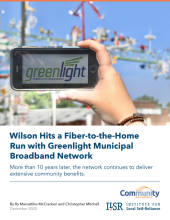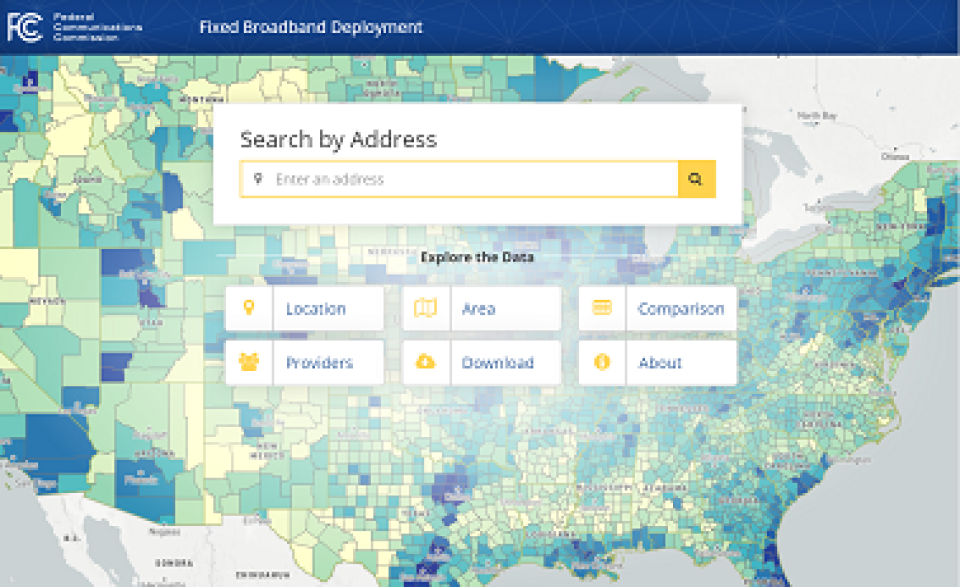
Fast, affordable Internet access for all.


For timely updates, follow Christopher Mitchell or MuniNetworks on Twitter and sign up to get the Community Broadband weekly update.
Built in 2008 with an eye toward the future and operated with local priorities in mind, Greenlight has a long track record of putting people first. In a new case study, the Institute for Local Self-Reliance explores the wide-ranging community benefits of Greenlight, the city-owned Fiber-to-the-Home network in Wilson, North Carolina.
Download Wilson Hits a Fiber-to-the-Home Run with Greenlight Municipal Broadband Network.
The case study details how it has been able to quickly adapt and expand service during the pandemic, as well as the host of advantages and overall value brought to the city over the last decade in education, equity, and economic development. For example:
Access for All
Economic Development
Education
In a new case study, the Institute for Local Self-Reliance explores the wide-ranging community benefits of Greenlight, the city-owned Fiber-to-the-Home network in Wilson, North Carolina. The case study details how it has been able to quickly adapt and expand service during the pandemic.
Built in 2008 with an eye toward the future and operated with local priorities in mind, Greenlight has a long track record of putting people first. A few examples are:
Access for All
Economic Development
Education
On Episode 4 of Connect This! Christopher is joined by Jeff Christensen (President, EntryPoint Networks), Dane Jasper (CEO and Co-Founder, Sonic), and Travis Carter (CEO, US Internet) to talk about open access models, and the challenges and opportunities they present. During the discussion they discuss barriers to entry, differentiation, dark fiber, and why we don't see more cities pursuing projects like this. They also have a little fun sharing what they think the FCC has gotten right and wrong over the last 4 years, and what Comcast's recent announcement about bandwidth caps will mean for users and competing Internet Service Providers (ISPs).
Mentioned during the episode was Chris' conversation with NetEquity Networks' Isfandiyar Shaheen and Althea Networks' Deborah Simpier about innovating financing models for expanding fiber networks.
Subscribe to the show using this feed.
Read the transcript for this episode.
As House GOP leaders ask the Government Accountability Office to audit the U.S. Department of Agriculture (USDA) ReConnect program because of concerns federal funds are being used to “overbuild,” Democratic leaders in the House and Senate have filed legislation that aims to build broadband infrastructure on a national-scale.
The Accessible, Affordable Internet for All Act is a bill that harkens back to when the federal government – through FDR’s Rural Electrification Administration, established in 1935, and the Rural Electrification Act, passed by Congress in 1936 – invested in local cooperatives and brought electricity to the abundance of Americans still living in candle-lit homes without electrically-powered refrigerators.
The proposed legislation may well frame the Democratic agenda on broadband moving forward, as the Biden administration enters the White House in January. It’s a bold bill that has garnered the support of a who’s-who of broadband experts and advocacy organizations from Public Knowledge, the National Consumer Law Center and New America Foundation’s Open Technology Institute to the Benton Institute for Broadband and Society, the Electronic Frontier Foundation, and the National Digital Inclusion Alliance.
Breaking it Down
There’s a lot to unpack in this bill, which is why we are publishing a series of posts exploring the major sections contained in the proposed legislation. This first installment is the 30,000-foot view. Forthcoming posts will examine the legislative details where the devil – or the better angels – can be found.

On Episode 3 of Connect This!, Christopher is joined by Angela Siefer, Executive Director of the National Digital Inclusion Alliance, Deb Socia, President of The Enterprise Center in Chattanooga, Tennessee, and Travis Carter, CEO of US Internet.
Tune is to hear them talk about solving the broadband gap and all of the obstacles it presents, from digital literacy training, to redlining, to funding programs. Along the way they also talk about how the federal government has failed to connect people over the last nine months and whether they're optimistic about a Biden administration and the future of broadband.
Mentioned during the course of the episode: An episode of the Community Broadband Bits Podcast with Deb Socia and Geoff Millener about digital inclusion in Chattanooga during the early months of the pandemic, and a white paper about tier flattening by Verizon and AT&T which forces users to pay high costs for decaying broadband infrastructure.
Subscribe to the show using this feed.
Watch the episode below.
ETI Software Solutions sponsored an event to help untangle the set of considerations facing communities discussing what route they want to take to improve Internet access for families and businesses in the community.
Heather Gold (HBG Strategies) presided over the panel which included ILSR's Christopher Mitchell as well as Ben Fineman, President of the Michigan Broadband Cooperative, Steve Lang, IT Manager for the city of Wadsworth, Ohio and its CityLink Fiber, and Will Aycock, General Manager of the Greenlight Network in Wilson, North Carolina. They cover a lot of ground, from the different models worth considering, to the phases of planning, to financing, construction, and customer service.
Watch the video at ETI's YouTube channel, or below.
This afternoon we hosted a YouTube Live event to talk about a model for financing Fiber-to-the-Home (FTTH) networks with the potential to dramatically expand ultrafast Internet access at affordable rates with no large upfront costs to homeowners. Christopher was joined by Deborah Simpier, CEO of Althea Networks, to talk with NetEquity Networks Founder and CEO Isfandiyar Shaheen (Asfi) about how it works, and dig into practical questions about its potential to fiberize rural America. This “fiber condominium” approach pairs collectively owned network infrastructure with the equity boost that comes with bringing symmetrical gigabit access to residential housing.
Watch the recording below, and read more about the approach.
Join us for a special livestream next week on Thursday, November 19th, from 3-4pm (CST). We’ll be talking about a model for financing Fiber-to-the-Home (FTTH) networks with the potential to dramatically expand ultrafast Internet access at affordable rates with no large upfront costs to homeowners. This “fiber condominium” approach pairs collectively owned network infrastructure with the equity boost that comes with bringing symmetrical gigabit access to residential housing.
In this Community Broadband Networks special livestream from ILSR, Christopher will be joined by Deborah Simpier, CEO of Althea Networks, to talk with NetEquity Networks Founder and CEO Isfandiyar Shaheen about how it works, and dig into practical questions about its potential to fiberize rural America.
Less than a third of the nation currently enjoys fiber connectivity, with the remainder stuck with cable or DSL. At least 14 million Americans lack wireline connectivity whatsoever.
We look forward to having you join us for the conversation, and welcome your questions during the stream!
What: Discussing A New Financing Model for Fiber Expansion on YouTube Live
When: Thursday, November 19th, 3pm CST
Where: YouTube Live: https://www.youtube.com/watch?v=J37pWLLHEnM
Who: Christopher Mitchell (ILSR), Deborah Simpier (Althea Networks), and Isfandiyar Shaheen (NetEquity Networks)
Don't miss interviews and other video content from ILSR; subscribe on YouTube!
This piece was written by Christopher Mitchell and Ry Marcattilio-McCracken
The second round of Techdirt’s Greenhouse Policy forum lands on the topic of broadband in the age of Covid and brings together a collection of voices speaking to facets of an important conversation. “The triple whammy of limited competition, regulatory capture, and Congressional corruption,” Karl Bode writes in introduction, “has resulted in the U.S. being utterly mediocre (or worse) in nearly every major broadband metric that matters.” Deb Socia and Geoff Millener have contributed to talk about online education, Harold Feld writes about radio spectrum, Terique Boyce talks about New York City’s Master Plan, and Jonathan Schwantes writes about treating broadband like a public utility. We likewise contributed an essay on community broadband and the steps local governments have taken to get citizens connected.
We encourage you to read it over at Techdirt, but will repost it below.
***
When it comes to the goal of ensuring all Americans have affordable and reliable Internet access, we are pretty much stalled. Sure, the FCC will make noise every year about our quest to bridge the digital divide, but it has focused solely on for-profit private solutions. And while there are many hundreds of good local companies making important local investments, the FCC has tended to throw the most money at the few extremely big ones (the same big ones that are on the other side of the revolving door at the FCC for most employees, whether staff or political appointees.)
As Vermont’s nascent Communication Union Districts (CUD) push to bring universal, truly high-speed Internet connectivity to the more rural parts of the Green Mountain State, CUD leaders are calling for changes in how federal funds get funneled to local municipalities, and for a change in how the federal government defines “high-speed” access.
Enabled by a 2015 Vermont law that allows two or more towns to join together as a municipal entity to build communication infrastructure, these local governmental bodies were formed to help the state reach its goal of having universal access to broadband by 2024. The idea is for CUD’s to operate like a water, sewer, or school district as a way for local communities to build their own broadband infrastructure. Establishing a CUD also puts rural regions of Vermont in a position to borrow money on the municipal bond market and eases access to grants and loans to fund broadband projects.
The formation of Communication Union Districts across the state began to pick up steam in the months following Gov. Phil Scott’s signing of H.513 in June of 2019. That legislation, which set aside $1.5 million to support broadband projects, increased funding to help provide Internet service in unserved or underserved parts of the state. It also created a new Broadband Expansion Loan Program within the Vermont Economic Development Authority (VEDA) to assist start-up broadband providers in developing community-based solutions.
Funding Gaps
In a Zoom call last month with U.S. Rep Peter Welch, D-Vt., leaders from the state’s nine CUD’s met virtually with Welch to update the congressman on the status of their efforts and what they see as crucial to succeed in fulfilling their mission without burdening taxpayers.